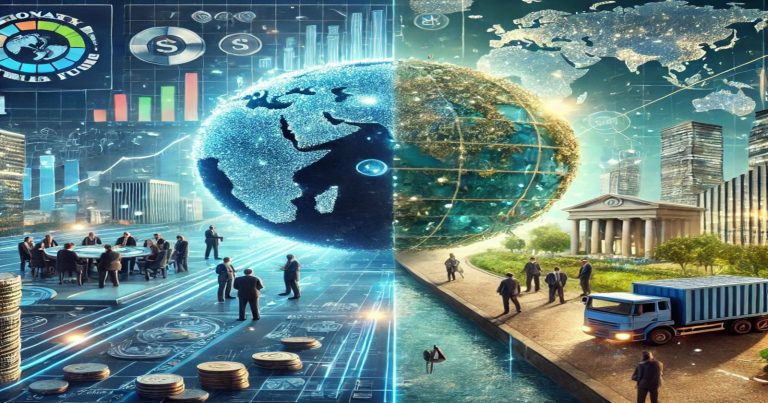IMF and World Bank are the most important topics in international money and economics devices. It plays a major role in the stability of the global economy but serves different purposes. The former concentrates on short-term financial assistance for economic stabilization, whereas the latter tends to be more concerned with long-run economic development and poverty alleviation. Collaboratively, these institutions promote global economic stability but differ structurally, by source of funding, in their operational roles and purposes.
What is IMF?
The term International Monetary Fund (IMF) is synonymous with an international monetary and economic cooperative institution founded to provide funds to ensure global financial stability. The conference of 1944 at Bretton Woods established the IMF to provide money, policy advice, and technical assistance to its member countries more than 190, thereby preventing financial crises in their economies, stabilizing exchange rates, and lending them short-term cash for balance-of-payment difficulties. The IMF promotes sound economic policies and structural reforms to help member countries achieve sustainable economic growth and financial stability.
History and Establishment of IMF
It was the Great Depression and the Second World War which necessitated the creation of the IMF. Still, however, the Bretton Woods conference established its foundations to ensure that the exchange rates would stabilize and that crises would unlikely happen. Initially, there was something akin to a system of fixed exchange rates supported by the IMF. Still, then after the Bretton Woods world crumbled during the 1970s, the organization moved on to develop a more flexible mechanism.
Structure of IMF
- Board of Governors: It is the highest decision-making body, comprising all countries as representatives.
- Executive Board: Comprised of 24 directors representing member countries. They handle daily business.
- Managing Director: Topmost of IMF, looking after all policies and programs of IMF.
- Quota System: Each member country contributes a financial share (quota), which determines the organization’s voting power and borrowing limits.
- Technical and Advisory Staff: Experts in providing economic analysis and policy formulations.
What is World Bank?
The World Bank is a world international financial institution for poverty eradication and long-term economic development. It was founded in 1944 along with the IMF and provided low-interest loans, grants, and technical assistance to developing countries. Most program objectives include funding infrastructure, education and healthcare facilities, and sustainable economic growth. The focus on short-term financial stability is distinct from that of the IMF; its focus areas include long-term development features to enhance the quality of life in lower-income nations and make them economically resilient.
History and Evolution of World Bank
The postwar reconstruction was the main concern of the World Bank at its inception. Still, it added much to its work in poverty alleviation, sustainable development, and infrastructure financing over time. It is now one of the largest development funding institutions in the world and lends and grants vast sums to needy countries.
Structure of the World Bank
- International Bank for Reconstruction and Development (IBRD): Provides loans to middle-income countries.
- International Development Association (IDA): Provides low-interest loans and grants to low-income countries.
- International Finance Corporation (IFC): Providing Investment and advisory services for the private sector development.
- Multilateral Investment Guarantee Agency (MIGA): Insurance against political and economic risks.
- International Centre for Settlement of Investment Disputes (ICSID): Settlement of investment disputes between countries and foreign investors.
Difference Between IMF and World Bank
IMF and World Bank are the most important topics in international money and economics devices. It plays a major role in the stability of the global economy but serves different purposes. The former concentrates on short-term financial assistance for economic stabilization, whereas the latter tends to be more concerned with long-run economic development and poverty alleviation. The difference between IMF and World bank are as follows :-
| Feature | International Monetary Fund (IMF) | World Bank |
| Established | 1944 at the Bretton Woods Conference | 1944 at the Bretton Woods Conference |
| Primary Purpose | Economic stability and short-term financial assistance | Long-term economic development and poverty reduction |
| Focus | Financial stability, exchange rates, and international trade | Infrastructure, education, healthcare, and poverty alleviation |
| Membership | 190+ countries | 189 member countries |
| Funding Sources | Contributions (quotas) from member countries | Borrowings from financial markets and member contributions |
| Lending Policies | Short-term financial assistance with economic reforms | Long-term loans and grants for development projects |
| Economic Impact | Prevents financial crises and stabilizes economies | Reduces poverty and supports infrastructure development |
| Structure | Executive Board and Managing Director | Five organizations under the World Bank Group |
| Policy Influence | Influences monetary policies, exchange rates, and fiscal policies | Supports structural reforms, public sector growth, and sustainable development |
| Loan Conditions | Countries must follow strict economic reforms and austerity measures | More flexible conditions aimed at development goals |
IMF Goals and Objectives
The IMF promotes global financial stability by monitoring exchange rates, encouraging international trade, and assisting countries facing economic crises with financial support. Its objectives are to foster development with sustainability, further poverty reduction, and advise member countries on sound policy-making in managing their fiscal and monetary affairs.
- Keeping Monetary Cooperation among Members: The International Monetary Fund (IMF) promotes cooperation among member states in pursuance of stable exchange rates and free international trade.
- Financial Assistance: It grants loans to countries under crises or balance-of-payments stress.
- Economic Stability: The IMF is alert to developments in the global economy to prevent possible instability and fluctuations in currencies.
- Promotion of Economic Growth: The IMF supports sound economic policies for growth and employment.
- Technical Assistance: Advised by the IMF on monetary and fiscal policies and other reform proposals.
Functions of IMF
Financial assistance is needed in the short term for those countries that experience a crisis in the balance of payments or instability in their economies. It also exercises surveillance by analyzing global financial trends and recommends measures for economic policies to governments. Lastly, the IMF is involved in building the capacity for financial institutions and governance frameworks.
- Surveillance: The organization will see that with the understanding of a global monitoring pattern, every characteristic economic variable is considered, and action is suggested to avoid financial crises.
- Financial Assistance: offer short-term credits for payment imbalances.
- Policy Recommendation: Recommendations will be made in the areas of fiscal policies, exchange rates, and monetary policies.
- Technical Support: Support in improving financial institutions and strengthening governance structures for countries.
- Capacity Development: IMF training courses for policymakers on economic management and financial planning.
Role of IMF in the Global Economy
The IMF has a very important role in the present scenario for ensuring stability in the international economy against any financial crisis and helping countries recover from an economic downturn. The IMF is a backup lender, providing financial assistance and structural reforms when economies get into trouble.
- Prevention of Financial Crises: The IMF allocates resources to intervene in the economy during financial disasters.
- Stabilizes Exchange Rate: Promote fixed or stable exchange rate policies facilitating global trade.
- Emergency Assistance: During economic crises, the IMF is available quickly to provide financial aid to distressed nations.
- Encourages Policymaking Reform: Structural adjustment programs are placed as conditions for borrowing countries to achieve long-term stability.
- Global Economic Risk Monitor: The IMF assesses and helps countries mitigate possible threats to their economies.
Aims of World Bank
The World Bank aims to alleviate poverty and promote sustainable economic growth through long-term finance. Infrastructure, education, health, and agriculture will be improved in developing countries, and financial capacities will be built for changed conditions as a direct result of the project. The World Bank funds them to build resilience.
- Reduction of Poverty: The Bank alleviates poverty through development financing.
- Promote Economic Growth: Long-term infrastructure, e-health investments, and education are what it funds.
- Sustainable Growth Boost: Projects for economic and environmental sustainability are the projects they support.
- Jobs: Finance projects create jobs and better livelihoods.
- Enhanced Social Services: The Bank supports health and education plus social security.
Functions of the World Bank
The World Bank aims to support infrastructure development, education, and public health projects in developing countries through the instruments of low-interest loans and grants. The World Bank also administers policy advice and technical assistance, aiding governments in effectively implementing economic reforms. It acts as a funding source for business initiatives that create jobs and promote economic development by encouraging private sector development.
- Infrastructure Financing: Roads, bridges, and other transport projects, all funded by the World Bank, are designed to promote the economic development of an area.
- Human Resource Development: Education, health, and other social programs must be developed to improve human capital.
- Financial Aid to Government: The World Bank gives low-interest loans for an economic development project.
- Promotion of Private Sector Development: This will generate more jobs and innovation.
- Environmental Protection Initiatives: World Bank-financed projects focus on sustainability and mitigating climate change effects.
Role of the World Bank in the Global Economy
The World Bank has a key function in the economic world, as it organizes funds to invest in huge development projects that will eventually change conditions in poorer developing countries. It further narrows the gap between poorer nations and those that have achieved the status of developed by establishing growth that will be stable for all nations, thus contributing significantly to the future of global stability and economies.
- Further long-term development: Unlike the IMF, which uses short-term stability as a measure, the World Bank is more stakeholder-friendly since it will invest in the longer-term growth potential of an economy.
- The Eradication of Global Poverty: The funding provides citizens of the poorest countries with programs to uplift their life standards.
- Development of Financial Institutions: The World Bank helps countries strengthen their financial systems.
- Facilitating Economic Reforms: It advises governments on policy changes to bring economic growth.
- Enhancement of Trade and Investment: Trade facilitation and market development to help countries participate effectively in the global economy are methods the World Bank uses.
IMF vs World Bank FAQs
1. What is the difference between the IMF and the World Bank?
While the IMF focuses on short-term assistance and financial stability, the World Bank funds long-term development projects. When it comes to the purpose of the IMF against that of the World Bank, while the IMF is about macroeconomic policies, the latter is about physical infrastructure and social development.
2. What are the IMF and World Bank’s contributions to the global economy?
The economic impacts of the IMF and World Bank differ. While the MF prevents economies from undergoing financial crises, the World Bank supports sustainable development through financing infrastructure, education, and healthcare projects.
3. What are the differences between the IMF and the World Bank regarding their lending policies?
The IMF is economically oriented in its purposes and terms of providing loans to countries, whereas the World Bank emphasizes the longer term; it lends for longer periods and sometimes grants to countries for development projects.
4. How do IMF and World Bank differ from each other in terms of membership?
The differences are minor since both institutions have almost the same member countries. However, both institutions differ significantly concerning their structures and functions.
5. How does the IMF give funds to its member countries?
Whereas the World Bank largely relies on raising money from the financial markets, both IMF and World Bank funding sources attest to the argument that member nations contribute to the IMF.


